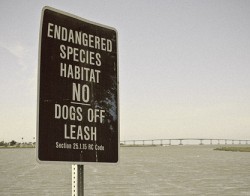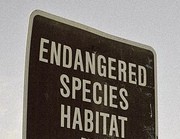 Photo: Reed LakefieldLast week, Todd Woody wrote a great piece in The New York Times about the growing crisis around the Endangered Species Act, as the Fish and Wildlife Service is overwhelmed with new applications for species in danger.
Photo: Reed LakefieldLast week, Todd Woody wrote a great piece in The New York Times about the growing crisis around the Endangered Species Act, as the Fish and Wildlife Service is overwhelmed with new applications for species in danger.
NYT’s Room for Debate asked me and some other folks to weigh in on the piece. You can read responses from:
- Jonathan H. Adler, Case Western Reserve law school: Overdue for Reform
- Holly Doremus, U.C. Berkeley law school: The Law’s Great Strength
- Steven F. Hayward, American Enterprise Institute: Blame Partisan Environmentalists
- Lisa Heinzerling, law professor, Georgetown University: The Law of Big Problems
- J.B. Ruhl, environmental law professor: A Bridge to the Climate Future
First, let’s pause for a moment of silence. If Steve Hayward is accusing other people of being partisan, clearly irony is dead. … OK, here’s my entry in the discussion:
——
In the U.S., concern over human impacts on the natural world began with conservationism, an attachment to particular beloved places and creatures. Then, in 1960s and ’70s, the ecological movement helped show that the human footprint extends beyond specific locales — it is systemic, threatening whole species and ecosystems. Conservation gave way to environmentalism, the consciousness that brought 20 million Americans, 10 percent of the population, into the streets for the first Earth Day in 1970.
The Endangered Species Act is one of an extraordinary set of environmental laws passed in the wake of that event. It is designed with holism in mind, to protect not just species but “the ecosystems upon which they depend.” Similarly, the Clean Air Act was designed to address not just an enumerated list of pollutants but “air pollution which may reasonably be anticipated to endanger public health or welfare.” The green laws of the ’70s were meant to be living, developing programs, weaving ecological care into all the government’s industrial and land use choices. In a journal commentary last year, political scientists Christopher Klyza and David Sousa argued that virtually all environmental progress in the U.S. since the 1970s has been a matter of “green drift,” the slow, contentious unfolding and extending of those foundational laws. As long as they are not repealed they will continue progressing; it is their nature.
In 1988, a new chapter in that story began, when the Congressional testimony of climate scientist James Hansen revealed to the broader public that human impacts now extend beyond species and ecosystems to the atmosphere itself. There could be no more thought of preserving untouched places; no place is untouched by earth’s climate. The human footprint now covers the biosphere itself and all it contains.
And so environmentalism gave way to … well, no one knows what to call it yet. Climate change is a problem unlike any human beings have ever faced. Its effects on any one place cannot be prevented without preventing its effects on all places. No one country can address it unless all countries do. More than 20 years after Hansen’s testimony, the full import is still sinking in.
Among other things, the green laws of the ’70s have been rendered even more far-reaching than their authors intended. In order to prevent air pollution that can damage public health or protect the ecosystems on which America’s species depend, the U.S. must blunt the effects of climate change. There is no way to solve the domestic problems without solving the global problem. That’s why there is such a vicious political fight over the Clean Air Act’s extension to greenhouse gases, and why the Endangered Species Act is teetering on crisis, overwhelmed with the number of new species in danger.
How will the laws hold up under the legal and political pressure they face as their profound implications are pursued? Will the U.S. leaders grapple with the 21st century’s unique problems or sabotage the laws it has on the books and retreat into denial? In an ideal world, Americans would have an adult conversation about the best way to harmonize economic, energy, and environmental policy. But it seems adults can’t get a word in edgewise at this Tea Party, so for now the country will go where green drift takes it.




